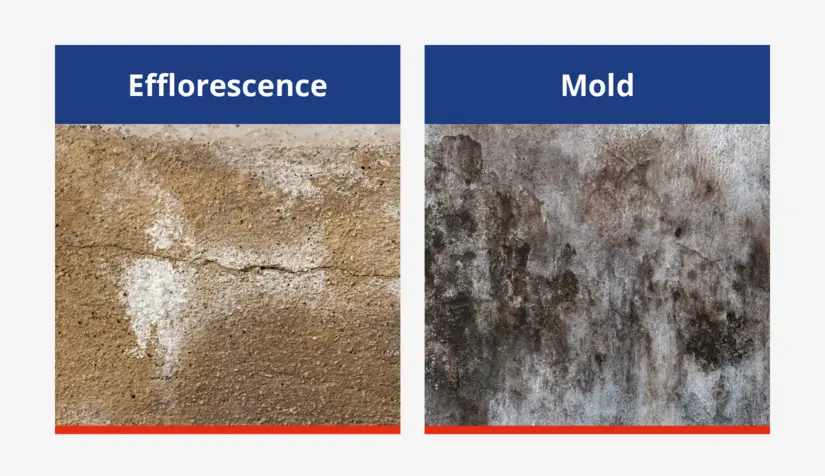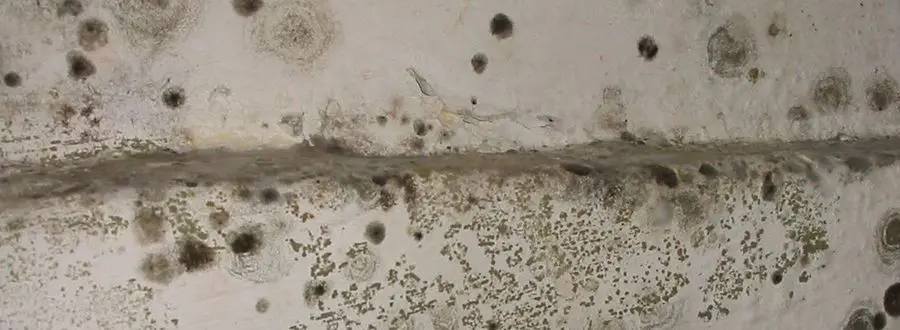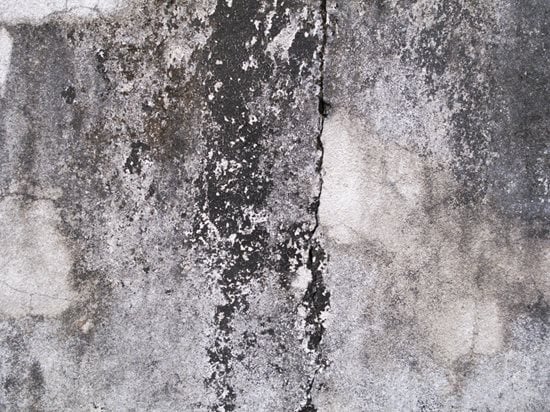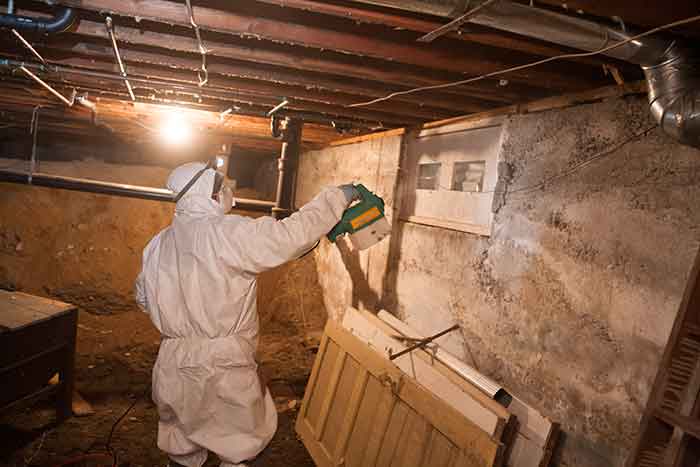
Can Mold Really Grow on Concrete?
Yes, mold can grow on concrete, even though the material itself isn’t organic. Mold requires moisture, a food source, and a suitable temperature to grow. While concrete doesn’t provide food for mold, it often traps dust, dirt, and other organic particles that mold can feed on. This, combined with high humidity or water exposure, can lead to mold growth on concrete surfaces such as basement walls, garage floors, patios, and driveways.
Mold spores thrive in environments with moisture, making areas like basements, where concrete is commonly found, particularly vulnerable. Water leaks, flooding, condensation, and poor ventilation can all contribute to mold growth on concrete. For more information on how mold forms and spreads in different environments, check out the EPA’s guide to mold basics.
How to Identify Mold on Concrete

Mold on concrete can sometimes be mistaken for dirt or stains, but there are a few telltale signs that mold may be present:
- Discoloration: Mold typically appears as black, green, or brown spots or patches on the surface of the concrete.
- Musty odor: Mold produces a strong, musty smell, especially in enclosed spaces like basements or garages.
- Dampness: If you notice dampness on the surface or around the edges of the concrete, this could indicate that moisture is trapped beneath the surface, creating the perfect environment for mold growth.
- Efflorescence: While not mold, efflorescence (a white powdery substance) can be a sign that moisture is seeping through the concrete, which could lead to mold growth.
If you’re unsure whether you’re dealing with mold or dirt, try cleaning a small patch. If it returns quickly or spreads, it’s likely mold. For a more detailed examination of mold in different parts of your home, schedule an inspection with Citywide Mold Mitigation.
How to Remove Mold from Concrete: Step-by-Step Guide

Once you’ve confirmed that mold is growing on your concrete surfaces, it’s time to take action. Mold removal from concrete requires thorough cleaning to ensure the spores don’t return. Here’s a step-by-step guide on how to remove mold from concrete safely and effectively:
| Step | How to Do It |
|---|---|
| 1. Wear Protective Gear | Mold can release spores into the air, which can cause respiratory issues and allergic reactions. Before starting, make sure to wear protective gloves, a mask (preferably N95), and safety goggles. |
| 2. Mix a Cleaning Solution | A mixture of white vinegar and water is an effective, natural solution for removing mold from concrete. Alternatively, you can use a commercial mold cleaner or a bleach solution (1 cup of bleach to 1 gallon of water). Avoid using too much bleach, as it can damage surrounding materials or discolor the concrete. |
| 3. Scrub the Mold | Use a stiff brush to scrub the moldy areas of the concrete. Apply your cleaning solution liberally and scrub thoroughly to break down the mold spores. Make sure to scrub beyond the visible mold, as spores can spread further than you might see. |
| 4. Rinse and Dry the Area | After scrubbing, rinse the area with clean water. You can use a hose or a bucket of water for this step. Once rinsed, it’s important to dry the area completely. Mold thrives in moisture, so drying the concrete is essential to prevent regrowth. |
| 5. Apply a Mold-Resistant Sealer | Once the concrete is clean and dry, consider applying a mold-resistant sealer. This will help protect the concrete from future mold growth by creating a barrier that prevents moisture from penetrating the surface. |
If mold has spread significantly or the concrete is located in a particularly moisture-prone area, it may be time to contact professionals like Citywide Mold Mitigation to assess and address the problem.
Natural Solutions for Removing Mold from Concrete

If you prefer eco-friendly cleaning methods, there are a few natural solutions that can effectively remove mold from concrete:
1. White Vinegar
White vinegar is an excellent natural mold remover. Mix equal parts white vinegar and water, then spray the solution onto the moldy concrete. Let it sit for 30 minutes to an hour before scrubbing the area with a brush. Rinse with water and allow the area to dry thoroughly.
2. Baking Soda
Baking soda is a gentle, natural cleaner that can neutralize odors and kill mold. Mix baking soda with water to create a paste, apply it to the moldy areas, and scrub with a brush. Rinse the area after scrubbing and ensure it dries completely.
3. Hydrogen Peroxide
Hydrogen peroxide is a natural mold killer that works well on concrete. Spray a 3% hydrogen peroxide solution directly onto the mold, let it sit for 10-15 minutes, and scrub the area with a stiff brush. Rinse and dry the area thoroughly.
These natural solutions are effective for small mold problems, but for larger infestations, it may be best to contact professionals. Learn more about mold removal tips at Family Handyman’s guide.
How to Prevent Mold from Growing on Concrete

Once you’ve removed the mold, preventing it from returning is key. Mold thrives in moist environments, so controlling moisture levels is critical. Here are a few tips to keep mold off your concrete surfaces:
1. Control Humidity
High humidity is one of the primary causes of mold growth. Use a dehumidifier in areas with concrete surfaces, like basements or garages, to keep humidity levels below 50%. For outdoor concrete, ensure proper drainage to prevent water from pooling or seeping into the concrete. Learn more about humidity control with this dehumidifier guide from Consumer Reports.
2. Improve Ventilation
Good airflow can help prevent moisture from settling on concrete surfaces. Open windows and doors in enclosed spaces or use fans to keep the air circulating. In basements, installing ventilation systems or exhaust fans can help keep moisture levels low.
3. Seal Concrete Surfaces
Sealing your concrete with a mold-resistant sealer can help prevent moisture from penetrating the surface, reducing the risk of mold growth. Reapply the sealer as needed, especially in high-moisture areas or after heavy rain or flooding.
4. Fix Water Leaks
Leaking pipes, cracks in the foundation, or poor drainage can lead to excess moisture on or under concrete surfaces. Regularly inspect your home for leaks and fix them immediately to prevent water from seeping into the concrete and creating conditions for mold to thrive.
When to Call Citywide Mold Mitigation for Help
If mold on your concrete surfaces continues to return despite cleaning efforts, or if you’re dealing with a large-scale mold problem, it’s time to call in the experts. Mold can spread quickly, and removing it effectively requires professional techniques and equipment.
Citywide Mold Mitigation offers comprehensive mold removal services for concrete surfaces, basements, garages, and more. Our team will inspect your home, identify the source of the moisture, remove the mold, and implement solutions to keep it from coming back. Contact us today to schedule a consultation and protect your home from mold damage.
FAQ
| Question | Answer |
|---|---|
| Can mold grow on outdoor concrete? | Yes, mold can grow on outdoor concrete surfaces like driveways, patios, and sidewalks if there is moisture, dirt, or organic material present. Regular cleaning and sealing can help prevent mold growth. |
| What causes mold on concrete? | Mold on concrete is caused by the presence of moisture and organic material (like dust and dirt) that mold can feed on. High humidity, leaks, flooding, or poor ventilation can contribute to mold growth on concrete. |
| How do I stop mold from growing on concrete? | To prevent mold on concrete, control humidity, improve ventilation, seal the concrete with a mold-resistant sealer, and fix any water leaks or drainage issues. Regular cleaning also helps keep mold at bay. |
| Is mold on concrete dangerous? | Mold on concrete can be harmful if it spreads into your home and becomes airborne. Mold spores can cause allergic reactions, asthma, and other respiratory problems. It’s important to remove mold as soon as it’s spotted. |
| When should I call a professional for mold removal? | If mold covers a large area or if it keeps returning after cleaning, it’s best to call a professional like Citywide Mold Mitigation to assess the problem and provide effective mold removal solutions. |
If you’re dealing with mold on concrete surfaces, contact Citywide Mold Mitigation for expert mold removal and prevention services.

